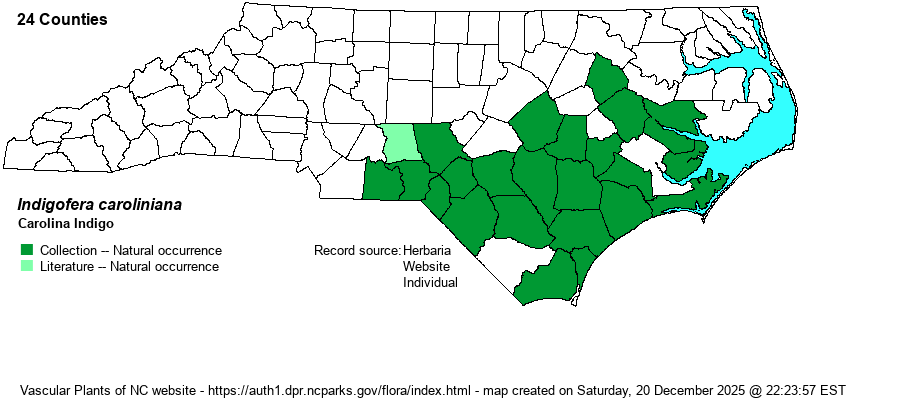| Author | P. Miller | |
| Distribution | Throughout the southern half of the Coastal Plain, renging north to Beaufort, Edgecombe, Johnston, and Moore counties -- these form the northern edge of the species' overall range.
This is a southern Coastal Plain species, ranging from eastern NC south to southern FL and LA. | |
| Abundance | Infrequent on the landscape, mostly in the Longleaf Pine (Pinus palustris) belts from Carteret County to Brunswick County near the coast, and in the Sandhills region farther west. Populations are widely scattered and generally small. | |
| Habitat | This is one of a great many legume species that favor sandy soils, particular where Longleaf Pine occurs. It favors Longleaf Pine/scrub oak sandhills, as well as Mesic Pine Flatwoods. It can be found in sandy woodland margins, roadsides, and other disturbed sandy places. It is not as limited to high-quality, frequently burned sites as are many other legumes, and it can survive better than many in disturbed sandy clearings. |
| Phenology | Blooms from June to August, and fruits from July to October. | |
| Identification | This is a semi-woody (suffruticose) herb that has a small shrub-like appearance, growing to about 3 feet tall with a number of widely spreading branches. The numerous leaves are divided into 9-15 leaflets, each leaflet being oblanceolate or obovate (wider above the middle), but only about 2/3-inch long and considerably narrower. There are numerous racemes, mostly from axils, growing to about 5 inches long; and these are populated by numerous fairly small flowers (about 1/3-inch across). However, they have an unusual color -- flesh-pink to salmon -- which makes them stand out from any other plant. The pods are quite small, only about 1/3-inch long. You should have little trouble identifying the species, especially when in bloom, as it is a "sub-shrub" with numerous leaflets per leaf and fleshy-salmon-pink flowers. Persons familiar with it can spot it instantly when vegetative owing to its somewhat bushy look. This species should not be too difficult to find in the Sandhills region, and somewhat less so in other areas with Longleaf Pine stands. | |
| Taxonomic Comments | None
| |
| Other Common Name(s) | None | |
| State Rank | S3 | |
| Global Rank | G4 | |
| State Status | | |
| US Status | | |
| USACE-agcp | | |
| USACE-emp | | |

